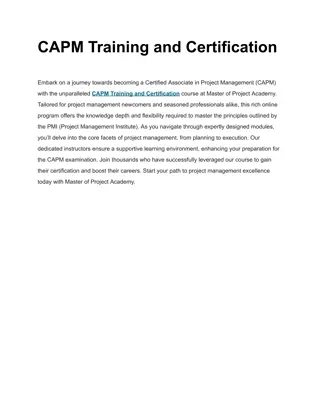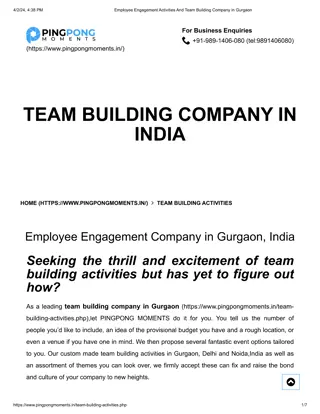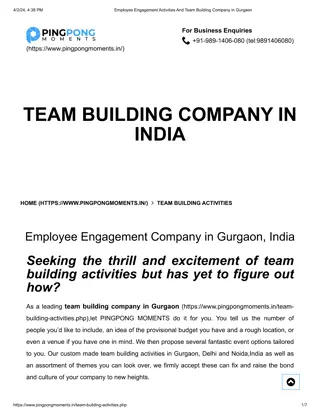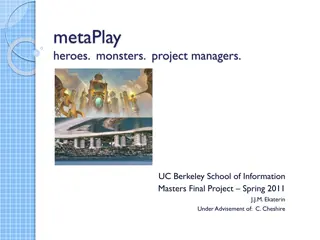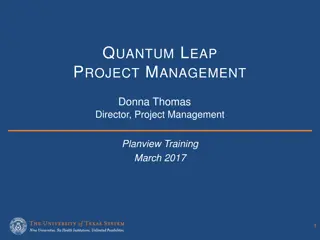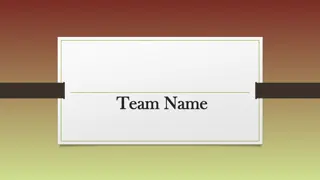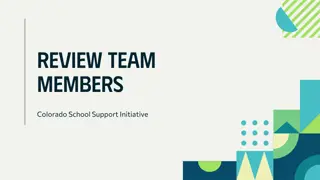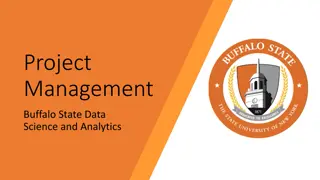Strategic Project Team Management for HR Professionals
This chapter delves into the essentials of managing project teams effectively, covering topics such as team needs, project stages, leadership advantages, building trust, motivators, managing transitions, diverse teams, Maslow's Hierarchy of Needs, and Tuckman's Stages of Team Development.
Download Presentation

Please find below an Image/Link to download the presentation.
The content on the website is provided AS IS for your information and personal use only. It may not be sold, licensed, or shared on other websites without obtaining consent from the author.If you encounter any issues during the download, it is possible that the publisher has removed the file from their server.
You are allowed to download the files provided on this website for personal or commercial use, subject to the condition that they are used lawfully. All files are the property of their respective owners.
The content on the website is provided AS IS for your information and personal use only. It may not be sold, licensed, or shared on other websites without obtaining consent from the author.
E N D
Presentation Transcript
Strategic Project Management: A Practical Introduction for HR Professionals Chapter 4: Project Team Creative Commons Attribution-NonCommercial-ShareAlike 4.0 International (CC BY-NC-SA 4.0) Creative Commons Attribution-NonCommercial-ShareAlike 4.0 International (CC BY-NC-SA 4.0) Unless otherwise noted, this work is licensed under a Creative Commons Attribution-NonCommercial-ShareAlike4.0 International (CC BY-NC-SA 4.0) license. Feel free to use, modify, reuse or redistribute any portion of this presentation.
4.1. Learning Objectives By the end of this chapter you should be able to: 1. Identify the basic needs of our team members. 2. Explain the stages that a project team goes through and be able to identify the role that a project manager should try to play during each stage. 3. List advantages of teams and strong leadership. 4. Discuss the role of trust in building a team, and describe behaviours that help build trust. 5. List motivators and de-motivators that can affect a team s effectiveness. 6. Explain issues related to managing transitions on a team. 7. Describe the advantages of diverse teams and provide some suggestions for managing them.
4.2 Successful Team As Laufer et al. (2018) explain in their book Becoming a Project Leader, When it comes to projects, one thing is obvious: right does not mean stars. Indeed, one of the primary reasons for project dream teams to fail is signing too many all-stars. More important than an all-star is a project team member fully committed to the project goals.
4.3 Developing Team Define the purpose of the team and the project (set goals) Measure the team s performance (establish metrics and reporting, monitoring performance Reward the team (as a motivator, and post project rewards Conduct team building exercises Provide motivation Understand and teach team development characteristics Teach skill development in project team compatibility: cooperation, communication, consoling, and conflict resolution Photo by Jason Goodman, Unsplash License
4.3 Maslows Hierarchy of Needs Biological and Physiological: What a person needs to survive, such as food, water, and shelter. Safety: The need to be safe, have financial security and protection against accidents and illness. Love and Belongingness: The need to be loved by one s family and community. Esteem: The need to be respected and valued by others. Figure 4-1: Maslow s Hierarchy of Needs Self-Actualization: The desire to become the best self you can.
4.3 Tuckmans Stages of Team Development Forming: group comes together, little agreement how to approach the project, require a lot of guidance 1. Tuckman's linear model of group development includes forming, storming, norming, performing, and adjourning Storming: team is figuring out their roles, conflict and power struggles may ensue, yet a clear vision, require support and coaching 2. Norming: develop consensus regarding roles, processes and approach; require facilitation 3. Performing: clear vision and purpose, meeting performance goals/milestones/benchmarks; require less supervision 4. Adjourning: collect lessons learned, transition to other work; require recognition and support to transition 5. Tuckman s Linear Model of group development by eCampus Ontario CC BY-SA 4.0
4.4 Human Resources and Supporting Teams to Building Trust Trust is based on beliefs related to their own ability, integrity and disposition to be good Trust is fragile HR provides trust building exercises with team and Project Manager Image by Anemone123, Pixabay License
4.4 Human Resources Helping Teams to Develop Communication Skills Teaching two-way communication tools to project teams helps increase positive communication 1. Formal Communication: questionnaires, surveys, mentoring programs, suggestion boxes, bulletin boards, email, handbooks, meetings 2. Information Communication: chatting, grapevine (information sharing ie lunch room), unofficial discussions, advice, small talk at beginning of meetings, telling stories Human Resources is in a good position to create opportunities to share and gather important information with teams Face-to-Face Communication: Send and receive messages simultaneously, offers feedback instantaneously, easy to interpret, captures body language Virtual Communication: Geographically dispersed, interact sending messages with meeting physically, save time and costs, convenient, team can be flexible with schedules, no physical space required
4.5 Team Motivation Ensure teams have a sense of purpose Ensure teams have clear performance metrics Assign the right tasks to the right people Encourage individual achievement, along with team achievement Do not take anything personally Provide mentoring Be consistent and follow through Image by Gerd Altmann, Pixabay License
4.6 Diversity, Inclusion, and Leadership The rationale for putting together a team is to combine different people, personalities, and perspectives to solve a problem. Diverse teams are more effective than homogenous teams because they are better at processing information and using it to come up with new ideas. Good teamwork depends, ultimately, on a leader with a clear understanding of what it means to lead Photo by rawpixel.com, CC0 1.0


